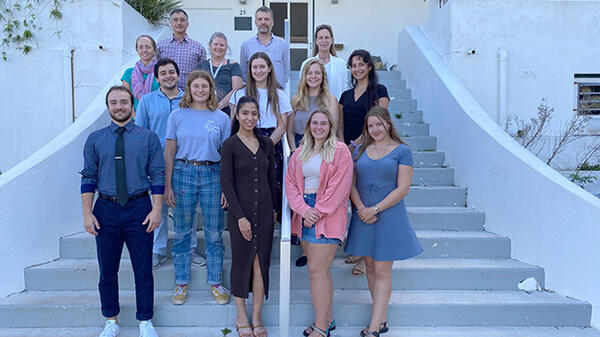Oceans are critical to stabilizing the world’s climate, absorbing a quarter of all carbon dioxide emissions and capturing 90 percent of the excess heat they generate. By some estimates, the ocean also accounts for up to half the annual emissions of another greenhouse gas – nitrous oxide (N2O), the third most important climate emission after carbon dioxide and methane. With the climate changing amid record high atmospheric levels of all three gases, the importance of the marine nitrogen cycle is ripe for study.
Nitrous Oxide Cycling Study Points to Microbial Networks Key to Maintaining the Balance of Marine Nutrients
July 24, 2023

Undergraduate Interns Leave BIOS With Key Skills, Lasting Friendships
January 02, 2023

Conducting research can be a career-defining opportunity for an undergraduate student. This experience helps build their CV for graduate school, it can open doors to internships and jobs, and many students present their results at international scientific conferences. Recognizing the increasingly critical role that independent research plays in science, technology, engineering, and mathematics (STEM) careers, each fall BIOS welcomes a cohort of undergraduate interns as part of the National Science Foundation (NSF) Research Experiences for Undergraduates (REU) program.
Illuminating Effects of Mesoscale Eddies on Coral Reefs
August 31, 2023

This summer marks year two of a three-year ASU BIOS study designed to expand understanding of how ocean eddies might be affecting coral reefs, as well as what role eddies may have played in reef accretion and overall functioning in the past.
ASU Announces New School of Ocean Futures
October 01, 2022

A new school dedicated to the study of the ocean and its ecosystems, and it is based in the desert?
New Postdoctoral Researcher Begins Work with BIOS
June 20, 2022

Murdock, 47, calls microbes the engines of the ocean. They’re responsible for feeding other sea life, breaking down waste, making oxygen, and absorbing carbon dioxide. These tiny creatures, among the oldest living organisms on Earth, range from algae and bacteria to fungi and plankton. In Murdock’s early teens she saw a National Geographic magazine featuring newly-discovered deep-sea hydrothermal vents teeming with giant clams, tube worms, and other marine life supported by nutrient-providing microbes. Since then, those ecosystems have been objects of her fascination.
A Sign of Summer: Students on Campus
May 25, 2022

Nicole Coots, a PhD student in her third year of evolutionary biology research at Arizona State University, is smitten by radiolarians, drifting plankton known for their complex, beautifully-sculpted miniature skeletons they make from minerals in ocean water. Like snowflakes, they seem to exist in almost unlimited variety. They are also key members of the food web throughout the surface waters of the global ocean, providing nutrition for other sea life.
Fall Interns Team up for Ocean Science Research Experiences
January 27, 2022

In 1991, BIOS became a site for the competitive and prestigious National Science Foundation (NSF) Research Experiences for Undergraduates (REU) program, which provides participants with the opportunity to work alongside the Institute’s faculty and staff on research projects in a variety of topics in ocean sciences.
A Nose for Nitrogen
June 08, 2016

Damian Grundle, on board the research vessel Atlantic Explorer, recently joined the BIOS faculty.
Finding Answers Blowing in the Wind
July 09, 2017

The research vessel Atlantic Explorer sailed from BIOS in June sporting a new instrument package on its mast and bow designed to measure climate-relevant, constantly shifting gases, moisture, and heat between the ocean and the atmosphere.
Potter, Chemist, BIOS Trustee
October 10, 2016

When science came calling for James Galloway in the mid-1970s, he was a potter building garden planters in a Virginia pool hall that he and friends had converted into a craft cooperative. He had recently earned a doctorate in chemistry from the University of California at San Diego, but after receiving the degree he felt burned out by academia. Instead, with his wife Nancy (a pastel artist and potter) and a group of jewelers, wood workers, and weavers, he spent his days throwing clay on a potter’s wheel.